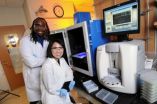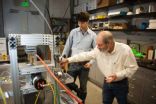(Press-News.org) Tendon injuries affect athletic horses at all levels. Researchers from the University of Connecticut are studying the use of stem cells in treating equine tendon injuries. Their findings were published Oct. 16 in the Journal of Animal Science Papers in Press.
Tendon injuries in horses tend to worsen over time as damage to the tendon creates lesions. Currently, horse owners treat tendon injuries by resting the horse and then carefully exercising the horse to control the growth of scar tissue in the tendon. Unfortunately, this treatment does not always work.
"These injuries result in lameness, which requires substantial recovery time and carry a high risk of re-injury," write authors S.A. Reed and E.R. Leahy.
Stem cells injections are already common veterinary medicine, and scientists are curious how to make stem cell treatments more effective. In this paper, the authors looked at the use of three types of stem cells: bone marrow-derived mesenchymal stem cells, adipose-derived stem cells and umbilical cord blood-derived stem cells.
These types of cells have the potential to strengthen a tendon after injury. Implants of bone marrow-derived mesenchymal stem cells (BMSC) can increase collagen production and organized collagen fibers in the tendon. Adipose-derived stem cells can express certain proteins important in healing.
However, stem cells are not a miracle cure. Implantation can be tricky, and stem cells do not always decrease recovery time. Some BMSC transplantations have also led to the growth of unwanted bone in the tendon.
Umbilical cord blood-derived stem cells (UCB) may have the most potential for healing horse injuries in the future. These cells may be better able to grow into new types of cells and repair tendon damage. So far there have been no studies of UCB use in actual horse tendon injuries. But in vitro studies show that UCB could be capable of tendon regeneration.
The authors recommend future studies into implantation techniques and the role of stem cells in different parts of the tendon. With this knowledge, horse owners, veterinarians and animal scientists can help keep equine athletes healthy.
###
This paper was based on a presentation at the 2012 Joint Annual Meeting. To read the paper in full, go to "Stem cell therapy in equine tendon injury."
Media contact:
Madeline McCurry-Schmidt / ASAS Communications
217-689-2435 / madelinems@asas.org END
Stem cells could heal equine tendon injuries
Cells from bone, fat tissue and umbilical cord blood can help animals heal
2012-11-01
ELSE PRESS RELEASES FROM THIS DATE:
LSUHSC research identifies new therapeutic target for Alzheimer's disease
2012-11-01
New Orleans, LA – Research led by Chu Chen, PhD, Associate Professor of Neuroscience at LSU Health Sciences Center New Orleans, has identified an enzyme called Monoacylglycerol lipase (MAGL) as a new therapeutic target to treat or prevent Alzheimer's disease. The study was published online November 1, 2012 in the Online Now section of the journal Cell Reports.
The research team found that inactivation of MAGL, best known for its role in degrading a cannabinoid produced in the brain, reduced the production and accumulation of beta amyloid plaques, a pathological hallmark ...
Rethinking reading
2012-11-01
Many educators have long believed that when words differ on only one sound, early readers can learn the rules of phonics by focusing on what is different between the words. This is thought to be a critical gateway to reading words and sentences.
But scientists at the University of Iowa are turning that thinking on its head. A recent study published in "Developmental Psychology" shows certain kinds of variation in words may help early readers learn better. When children see the same phonics regularities, embedded in words with more variation, they may learn these crucial ...
Laser-light testing of breast tumor fiber patterns helps show whose cancer is spreading
2012-11-01
Using advanced microscopes equipped with tissue-penetrating laser light, cancer imaging experts at Johns Hopkins have developed a promising, new way to accurately analyze the distinctive patterns of ultra-thin collagen fibers in breast tumor tissue samples and to help tell if the cancer has spread.
The Johns Hopkins researchers say their crisscrossing optical images, made by shining a laser back and forth across a biopsied tissue sample a few millionths of a meter thick, can potentially be used with other tests to more accurately determine the need for lymph node biopsy ...
George Mason University researchers target breast cancer in 3 trials
2012-11-01
Fairfax, Va. -- A malarial drug is showing promise in stopping breast cancer before it starts, Mason researchers are discovering during a clinical trial.
"The bold long-term goal is a short-term oral treatment that prevents breast cancer by killing the precursor cells that initiate breast cancer," says Lance Liotta, co-director of Mason's Center for Applied Proteomics and Molecular Medicine (CAPMM). "And it's looking hopeful."
The PINC trial (Preventing Invasive Neoplasia with Chloroquine) targets ductal carcinoma in situ, or DCIS, the most common type of pre-invasive ...
Researchers use blood testing to predict level of enzymes that facilitate disease progression
2012-11-01
Predicting how atherosclerosis, osteoporosis or cancer will progress or respond to drugs in individual patients is difficult. In a new study, researchers took another step toward that goal by developing a technique able to predict from a blood sample the amount of cathepsins—protein-degrading enzymes known to accelerate these diseases—a specific person would produce.
This patient-specific information may be helpful in developing personalized approaches to treat these tissue-destructive diseases.
"We measured significant variability in the amount of cathepsins produced ...
Mice with 'humanized' livers improve early drug testing, Stanford scientists show
2012-11-01
STANFORD, Calif. — Stanford University School of Medicine scientists have used bioengineered mice with livers composed largely of human cells to characterize a drug about to enter early-stage clinical development for combating hepatitis C.
Tests using the new mouse model accurately predicted significant aspects of the drug's behavior in humans — including its interaction with another drug and the profile of its major breakdown products in the body (called metabolites) — far more accurately than would have been achieved using current methods.
The study will be published ...
Regional analysis masks substantial local variation in health care spending
2012-11-01
PITTSBURGH, Oct. 31, 2012 – Reforming Medicare payments based on large geographic regions may be too bluntly targeted to promote the best use of health care resources, a new analysis from the University of Pittsburgh Graduate School of Public Health suggests. The analysis will be published in the Nov. 1 issue of the New England Journal of Medicine.
"Much policy attention has been drawn to the large geographic variation in health care spending across regions, and for good reason – because regional variation points to inefficient use of resources," said lead author Yuting ...
Tabletop fault model reveals why some quakes result in faster shaking
2012-11-01
Berkeley — The more time it takes for an earthquake fault to heal, the faster the shake it will produce when it finally ruptures, according to a new study by engineers at the University of California, Berkeley, who conducted their work using a tabletop model of a quake fault.
"The high frequency waves of an earthquake — the kind that produces the rapid jolts — are not well understood because they are more difficult to measure and more difficult to model," said study lead author Gregory McLaskey, a former UC Berkeley Ph.D. student in civil and environmental engineering. ...
Unexpected factor contributes to melanoma risk in red-haired, fair-skinned individuals
2012-11-01
The well-established elevated risk of melanoma among people with red hair and fair skin may be caused by more than just a lack of natural protection against ultraviolet (UV) radiation. In an article receiving Advance Online Publication in Nature, Massachusetts General Hospital (MGH) Cutaneous Biology Research Center (CBRC)and Cancer Center researchers report finding that the type of skin pigment predominantly found in red-haired, fair-skinned individuals may itself contribute to the development of melanoma.
"We've known for a long time that people with red hair and ...
Pond skating insects reveal water-walking secrets
2012-11-01
This month's special issue of Physics World is devoted to animal physics, and includes science writer Stephen Ornes explanation of how pond skaters effortlessly skip across water leaving nothing but a small ripple in their wake.
As Ornes writes, our current understanding of the mechanisms adopted by the pond skater is down to the efforts of David Hu, who as a mathematics graduate from the Massachusetts Institute of Technology spent four years studying their behaviour.
Hu, along with his PhD supervisor John Bush, found that pond skaters use the middle of their three ...
LAST 30 PRESS RELEASES:
An ECOG-ACRIN imaging study solves a long-standing gap in metastatic breast cancer research and care: accurately measuring treatment response in patients with bone metastases
Cleveland Clinic presents final results of phase 1 clinical trial of preventive breast cancer vaccine study
Nationally renowned anesthesiology physician-scientist and clinical operations leader David Mintz, MD, PhD, named Chair of the Department of Anesthesiology at the UM School of Medicine
Clean water access improves child health in Mozambique, study shows
Study implicates enzyme in neurodegenerative conditions
Tufts professor named Fellow of the National Academy of Inventors
Tiny new device could enable giant future quantum computers
Tracing a path through photosynthesis to food security
First patient in Arizona treated with new immune-cell therapy at HonorHealth Research Institute
Studies investigate how AI can aid clinicians in analyzing medical images
Researchers pitch strategies to identify potential fraudulent participants in online qualitative research
Sweeping study shows similar genetic factors underlie multiple psychiatric disorders
How extreme weather events affect agricultural trade between US states
Smallholder farms maintain strong pollinator diversity – even when far from forests
Price of a bot army revealed across hundreds of online platforms worldwide – from TikTok to Amazon
Warblers borrow color-related genes from evolutionary neighbors, study finds
Heat signaling from plants is an ancient pollinator signal
New index reveals the economics underlying the online manipulation economy
High-resolution satellite observations reveal facility-level methane emissions worldwide
Researchers discover how Ebola and Marburg disrupt the gastrointestinal tract
Feeling the heat
Eastward earthquake rupture progression along the Main Marmara Fault towards Istanbul
Scientists uncover how Earth’s mantle locked away vast water in early magma ocean
Scientists uncover key driver of treatment-resistant cancer
Rare image of Tatooine-like planet is closest to its twin stars yet
Music: Popular song lyrics have become more negative since 1973
Marine ecology: Killer whales tail dolphins to hunt salmon
ADHD prescriptions on the rise, study finds
How to build a genome
Sharp rise in ADHD stimulant prescriptions in Ontario, research finds
[Press-News.org] Stem cells could heal equine tendon injuriesCells from bone, fat tissue and umbilical cord blood can help animals heal

